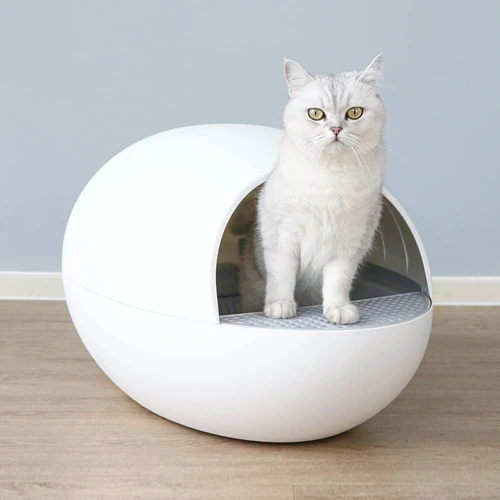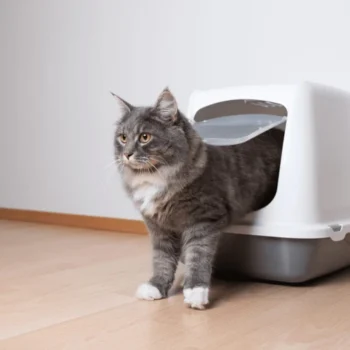As a devoted owner of an American Wirehair, you love your feline companion with every whisker on his unique coat of hair. However, one issue that can cause distress for both you and your furry friend is litter box problems. It can be hard to understand why your cat is avoiding or not appropriately using the litter box, but don’t worry; there are solutions. In this article, we’ll discuss the common and medical issues that can cause litter box problems in American Wirehairs. We’ll also explore the steps you can take to remedy these issues and provide tips for preventing future problems. By the end, you’ll have all the tools you need to create a comfortable and stress-free litter box environment for your feline companion.
Understanding Litter Box Problems

As a cat owner, dealing with litter box issues can be a challenging and frustrating experience. Every American Wirehair cat is unique, and there is no single solution to litter box problems that works for every cat. Understanding the various reasons why your cat may be experiencing issues with their litter box is crucial. In this section, we’ll explore the common and medical reasons behind litter box problems that your American Wirehair might be experiencing. Additionally, we’ll offer some tips for dealing with these problems to create a more comfortable environment for your furry friend. To learn more about training your American Wirehair kitten to use the litter box, check out our article on litter training tips.
Common Issues
When it comes to litter box problems with an American Wirehair, there are several common issues you may encounter. Here’s an overview of some of the most frequent problems and how to deal with them:
| Issue | Solution |
|---|---|
| Litter box avoidance: Your American Wirehair may begin avoiding the litter box altogether, choosing to eliminate elsewhere instead. | This issue can often be solved by identifying the cause of the behavior. Make sure the litter box is in a quiet, private location away from high-traffic areas of the home. Also, make sure you are keeping the litter box clean and that your American Wirehair has fresh litter available at all times. |
| Litter box aggression: Your American Wirehair may begin to show aggression towards other cats in the home while using the litter box. | If you have multiple cats, make sure you are providing enough litter boxes for each cat. Also, try placing the litter boxes in different locations to help prevent territorial issues. Consider offering an alternative type of litter box, such as a covered or top-entry box, to help reduce stress and prevent aggression. |
| Litter box overuse: Your American Wirehair may begin to use the litter box excessively, leading to frequent cleaning and possibly even health issues. | Make sure you’re providing a large enough litter box for your American Wirehair’s size and needs. Also, make sure you’re changing the litter frequently and that the litter box is located in a well-ventilated area. If the problem persists, consider offering an alternative type of litter box or litter type. |
If you’re experiencing any of these common issues with your American Wirehair, it’s important to address them as soon as possible. Not only do litter box problems create unpleasant living conditions, but they can also lead to health issues for your cat. For more information on understanding your American Wirehair’s litter box behavior, check out our article on Understanding American Wirehair Litter Box Behavior.
Medical Problems
Medical Problems are a common reason why a cat may stop using their litter box. If your American Wirehair suddenly stops using their litter box, it’s important to take them to a veterinarian to rule out any underlying medical issues. Here are some medical problems that may cause your cat to avoid their litter box:
| Medical Issue | Description |
|---|---|
| Urinary Tract Infection (UTI) | UTIs are common in cats and can cause discomfort and pain when urinating. Your cat may associate the litter box with pain and avoid using it. |
| Bladder Stones | Bladder stones can also cause pain and discomfort when urinating. This can lead to your cat avoiding the litter box. |
| Constipation | Constipation can cause discomfort and pain when your cat tries to defecate. Your cat may avoid their litter box if they associate it with discomfort. |
| Gastrointestinal Issues | Gastrointestinal problems like inflammatory bowel disease (IBD) can cause diarrhea and discomfort, leading your cat to avoid the litter box. |
| Arthritis | Arthritis can make it difficult for your cat to climb into their litter box, causing them to avoid using it. |
While these are just a few medical issues that can cause litter box problems in cats, it’s important to always consult with a veterinarian to discuss the best course of treatment for your American Wirehair. It’s also a good idea to have your cat regularly checked by a vet to catch any potential medical issues early on.
If you’re interested in learning more about litter box solutions for your American Wirehair, check out our article on the best litter box for American Wirehairs.
Steps to Take

After identifying the possible root cause of your American Wirehair’s litter box issue, it’s time to take action. The following steps will guide you on how to solve your cat’s litter box problems and prevent them from happening again in the future. From basic solutions to advanced fixes, we’ve got you covered. But before we proceed, it’s important to remember that cats are unique individuals, and their response to any intervention may vary. What works for one cat might not work for another, so be patient in your efforts to help your feline friend. Let’s get started.
Basic Solutions
When dealing with litter box problems, it’s essential to understand that basic solutions can be very effective. These solutions are easy to implement and don’t require any specialized training. The following table lists out the basic solutions that can be used to deal with litter box problems in American Wirehair cats:
| Solution | Description |
|---|---|
| Cleanliness | Ensure the litter box is cleaned on a regular schedule, at least once a day. Keeping the litter box clean will encourage your American Wirehair cat to use it. |
| Litter type | Experiment with different types of litter to see what your American Wirehair cat prefers. Use a fine-grain, unscented litter for sensitive cats, and avoid using harsh chemicals to clean the litter box. |
| Number of boxes | Provide multiple litter boxes if you have more than one American Wirehair cat in the household. A good rule of thumb is to have one litter box per cat, plus one extra box. |
| Location | Place the litter boxes in quiet and easily accessible areas. Avoid placing litter boxes near your cat’s food and water bowls. |
| Positive reinforcement | Use positive reinforcement techniques to encourage your American Wirehair cat to use the litter box. Rewarding your cat with treats and praise when they use the box can be effective. |
Keeping the litter box clean is the most important solution and should be the first step to take when dealing with litter box problems. Providing multiple litter boxes in different locations around the house will give your cat options to choose from and avoid creating a territorial problem. Experimenting with different types of litter can also help if your cat is picky about the type of litter used. Finally, creating a positive association between the litter box and your American Wirehair cat can be achieved by using positive reinforcement techniques such as reward or treats. Check out more useful tips on how to clean the litter box correctly and how to train an American Wirehair cat to use the litter box.
Advanced Solutions
If basic solutions fail, it’s time to try advanced solutions. These techniques require patience and determination, but can make a big difference in dealing with litter box problems.
1. Provide More Litter Boxes: If your American Wirehair is avoiding the litter box, it may be because they don’t like sharing with other pets or they simply need more boxes. The general rule is to have at least one litter box per cat, plus an extra one. So, if you have two cats, you should have three litter boxes. Place them in different locations around the house, and experiment with different types of litter and boxes.
2. Upgrade the Litter Box: Sometimes, cats are picky about their litter boxes. Try changing to a box with a top or one made of a different material, such as plastic or metal. Automatic litter boxes can also be a solution for some cats because they keep the box cleaner and the litter fresh. These can be expensive, though, so make sure it’s worth the investment.
3. Increase the Litter Box Size: Some cats need a larger litter box than average. If your cat is having trouble fitting inside the box or hitting the sides, try getting a bigger one. You may also want to try a deeper box if your cat tends to flick litter out.
4. Use Different Types of Litter: Some cats only like certain types of litter. If you’re using a scented litter, switch to an unscented one or vice versa. You can also try natural litters, such as pine or corn, or alternatives like shredded newspaper or sand. Just make sure the litter is safe for cats to use.
5. Try Litter Box Attractants: Some products are designed to attract cats to the litter box, such as catnip or pheromone sprays. These products can be sprayed inside the box or around the area to encourage your American Wirehair to use them.
Remember, it’s important to be patient when trying advanced solutions. Your American Wirehair may take some time to adjust or may still prefer their original routine. Be sure to also check out our article on American Wirehair litter box issues for additional tips and tricks.
Litter Box Maintenance

Maintaining a clean litter box is crucial for the overall health and well-being of your American Wirehair. Proper litter box maintenance can prevent various problems, such as litter box aversion, discomfort and even medical issues. Neglecting the litter box can lead to your feline friend resorting to other areas of your home to do their business. In this section, we will go over essential litter box maintenance tips that will keep the litter box pristine and your American Wirehair happy. But before we dive into it, be sure to check out our previous section on Understanding Litter Box Problems, which can help you identify potential issues.
Cleaning Tips
Maintaining a clean litter box is essential to keep your American Wirehair cat satisfied and avoid litter box problems. Here are some cleaning tips to help you out:
1. Scoop the waste at least once a day: Cleaning the litter box once a day is a must. Scooping out the waste every day will prevent the cat from making messes outside the box.
2. Dump the litter box regularly: Dumping the litter box weekly is important as it ensures that the litter remains fresh. You can also add a small amount of baking soda to the litter box, which will help control odors.
3. Use mild detergent: Use a mild detergent or soap to clean the litter box. Avoid using harsh chemicals as they might leave behind a residue that can harm the cat.
4. Rinse and dry the litter box: After cleaning the litter box, rinse it thoroughly and leave it to air dry. A wet litter box will not only cause the litter to clump but will also increase the chances of bacterial growth.
5. Replace the litter box occasionally: Over time, the litter box might start to accumulate scratches and dents, which can make it difficult to clean. It is recommended to replace the litter box every six months.
By following these cleaning tips, you can ensure that the litter box is clean and hygienic for your American Wirehair cat to use. Don’t forget that there are different types of litter boxes available in the market, such as covered, open, and self-cleaning litter boxes. Consider checking out our article on American Wirehair toilet training pros and cons to choose the best litter box for your cat.
Types of Litter
When it comes to selecting the right litter for your American Wirehair, there are several options to choose from. Each type of litter has its own advantages, disadvantages, and suitability for your cat’s specific needs. Here are some of the most common types of litter:
| Clay Litter | Crystal Litter | Paper Litter | Wood Pellets |
|---|---|---|---|
| Clay litter is the most common type of litter and is widely available. It is absorbent, clumps well, and helps control odor. However, some cats might not like the texture or dustiness of clay litter. | Crystal or silica gel litter is made of small, flat crystals that absorb moisture and odors. It is low-dust and can last longer than other types of litter, but might not absorb urine as well as other litters. | Paper litter is made from recycled paper and is biodegradable and low-dust. It is also suitable for cats with respiratory problems. However, it might not be as absorbent as other types of litter and can require more frequent changes. | Wood pellets are made from recycled sawdust and can be an eco-friendly option. They are highly absorbent, reduce odor, and are easy to dispose of. However, they might not clump as well as other litters and might not be as comfortable for some cats to walk on. |
It’s important to keep in mind that some types of litter might not be suitable for cats with certain medical conditions or preferences. It’s also a good idea to gradually introduce new types of litter to your American Wirehair to see how they respond to it. Experiment with different types of litter until you find the one that best suits your cat’s needs and preferences.
Litter Box Placement
When it comes to litter box problems, one important aspect that pet owners often overlook is the placement of the litter box. A poorly placed litter box can cause discomfort and inconvenience for your American Wirehair, leading to avoidance or inappropriate elimination. Here are some tips for ideal litter box placement:
- Accessibility: Make sure the litter box is easily accessible for your pet. Avoid placing it in cramped or narrow spaces, or in areas with obstructions such as doors and furniture. Your cat should be able to reach the box without any difficulty.
- Privacy: Cats naturally prefer privacy when using the litter box. Place the box in a secluded area where your pet can feel safe and secure. Avoid placing it in busy or noisy areas, such as the kitchen or living room.
- Multiple boxes: It’s a good idea to have multiple litter boxes if you have more than one cat in your household. Ideally, each cat should have their own litter box placed in separate locations to prevent territorial disputes.
- Avoiding food and water: Cats instinctively avoid eliminating near their food and water bowls. Keep the litter box in a separate area from your pet’s feeding area.
- Avoiding vibrations: Cats are sensitive to vibrations and may avoid using the litter box if it is placed in an area with frequent vibrations or noise, such as near a washing machine or HVAC system.
- Safe and secure: Make sure the litter box is stable and secure, and won’t tip over when your cat is using it. If you have a kitten, choose a shallow box that is easy to climb in and out of, and transition to a larger box as they grow older.
By following these tips, you can ensure that your American Wirehair has a comfortable and convenient place to do their business, and avoid litter box problems in the future.
Preventing Future Problems
As a responsible pet owner, it’s important to not only address current litter box issues with your American Wirehair, but to also take steps to prevent future problems from arising. By implementing certain measures and training techniques, you can ensure a clean and stress-free environment for both you and your feline friend. Let’s dive into some helpful tips and techniques to prevent future litter box problems from occurring.
Training Tips
One of the most effective ways to prevent litter box problems is by training your American Wirehair to use the litter box. By following some simple training tips, you can teach your cat good litter box manners and prevent future accidents.
Positive Reinforcement: The most effective way to train your cat to use the litter box is by using positive reinforcement. Whenever your cat uses the litter box, reward them with treats, playtime or verbal praise. This will encourage your cat to associate good behavior with rewards.
Consistent Schedule: By creating a consistent schedule for feeding, playing and litter box use, you can help your American Wirehair develop a routine. This will allow your cat to know when to expect to use the litter box and can prevent accidents.
Limited Room Access: To prevent your cat from having accidents in other areas of the house, it is best to limit your American Wirehair’s access to one room or area at first. Once your cat has consistently used the litter box, you can slowly increase your cat’s access to other areas of the house.
Use Litter Attraction: To encourage your cat to use the litter box, try using a litter attractant. These products contain scents that attract cats to the litter box.
Patience: Remember to be patient and understanding during the training process. Cats have their own unique personalities and may take longer to adjust to new routines.
| Training Tips | Description |
|---|---|
| Positive Reinforcement | Reward your cat with treats or praise when they use the litter box |
| Consistent Schedule | Create a routine for feeding, playing and litter box use to establish good habits |
| Limited Room Access | Start by giving your cat access to one room or area to prevent accidents in other parts of the house |
| Use Litter Attraction | Use a litter attractant to encourage your cat to use the litter box |
| Patience | Be patient and understanding during the training process |
Behavioral Correction
Behavioral correction is an important aspect in dealing with litter box problems in American Wirehair cats. This method involves identifying your cat’s underlying behavioral issues that may be causing their litter box problems and providing a solution to address those problems.
One common behavioral issue in cats is anxiety, which can often lead to avoiding the litter box. If you suspect anxiety is a problem for your American Wirehair, consider using pheromone sprays that create a calming environment for your cat. Additionally, try to create a quiet and comfortable space for your cat’s litter box away from high-traffic areas or noisy appliances like washing machines or dryers.
Another common behavioral issue is territorial marking, which is when a cat urinates outside of the litter box to mark their territory. To address this issue, ensure that you have multiple litter boxes available, as cats prefer to have separate areas for urination and defecation. Also, make sure to keep litter boxes clean and in a location that provides privacy for your cat.
Table of Behavioral Correction Tips:
| Behavioral Issue | Behavioral Correction |
|——————|———————–|
| Anxiety | Use pheromone sprays or a quiet space for the litter box |
| Territorial marking | Provide multiple litter boxes and keep them clean and in a private location |
By addressing behavioral issues and providing solutions specific to your cat, you can help to prevent future litter box problems for your American Wirehair. Remember to be patient and consistent in your approach, as changes may take time to take effect. With the right behavioral correction techniques, you can help ensure that your cat is happy and healthy with a consistently clean litter box.
Conclusion
After going through the various solutions for dealing with litter box problems in American Wirehairs, it is important to note that the solution to this problem varies from one cat to another. However, with patience, proper understanding of your cat’s behavior, and consistency, you should be able to find a viable solution to the problem.
It is essential to note that cats have their unique personalities and behavioral traits, making them different from each other. Therefore, it’s necessary to take your cat’s individuality into consideration when dealing with litter box problems.
In conclusion, litter box problems can be pretty frustrating, but with the right approach, they can be quickly resolved. Remember to keep the litter box clean, provide adequate training, and seek medical attention when necessary. By following the steps outlined in this article, you and your furry friend can enjoy a stress-free litter box experience. So stay calm, be patient, and keep trying different methods until you find the solution that works best for your American Wirehair.
Frequently Asked Questions
Why is my American Wirehair Cat not using the litter box?
There are several reasons why your American Wirehair may not be using the litter box, including stress, medical problems, and issues with the box itself.
How often should I clean the litter box?
You should scoop out solid waste and urine clumps daily and completely change the litter in the box once a week.
Can the type of litter I use affect my cat’s litter box behavior?
Yes, cats may have preferences or aversions to certain types of litter, so it’s important to try different options to find what works best for your cat.
What are some signs that my cat may have a medical problem causing litter box issues?
Signs of medical problems can include urinating frequently or in unusual places, straining to urinate, blood in urine, and excessively licking the genital area.
How can I train my American Wirehair cat to use the litter box?
Gradually introduce your cat to the litter box and reward them with treats or praise when they use it correctly. Consistency is key.
What are some options for litter box placement?
Litter boxes should be placed in a quiet, easily accessible area and away from food and water bowls. Some cats prefer a level of privacy, so a covered litter box may be an option.
Should I have one litter box or multiple for my American Wirehair Cat?
It’s recommended to have at least one litter box per cat in the household, plus an additional box as backup.
Can stress play a role in litter box issues?
Yes, cats can experience stress due to changes in routine or environment, which may lead to litter box problems. Creating a calm and predictable environment can help reduce stress.
Will behavioral correction techniques help with litter box issues?
Behavioral correction can be effective in addressing litter box problems, but it’s important to first rule out any underlying medical issues and address them appropriately.
What are some common mistakes cat owners make with litter box maintenance?
Common mistakes include using scented litter or cleaning products, not cleaning the box frequently enough, and not providing a large enough litter box for the cat.







